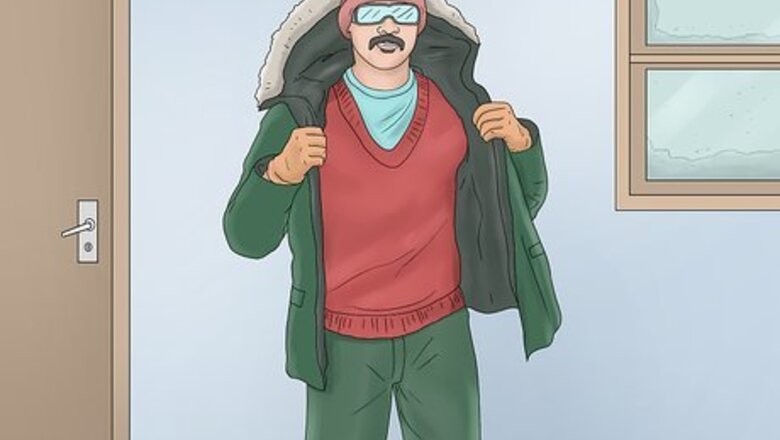
views
Preparing to Dig Out
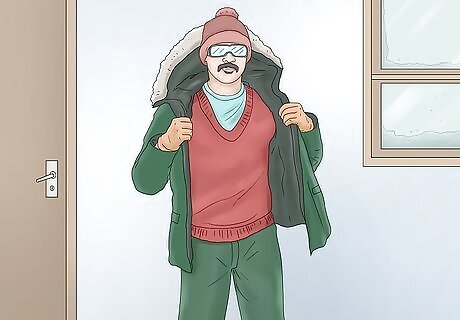
Dress warmly. You may be out in the cold for a while to complete this task so be sure to wear warm clothes. You’ll need a waterproof jacket, pants, and boots. Wear gloves to keep your hands warm, as well as a hat to maintain your body temperature. Wear layers in case you get too warm from the exertion and need to remove an article of clothing. Getting wet can not only make you quite cold, it can also lead to frostbite. Be sure all your outer layers are waterproof!
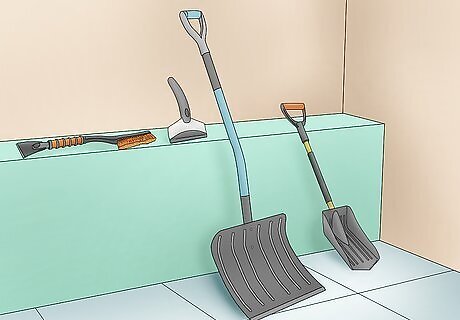
Gather the right tools. You’ll need a shovel for clearing the area around your car as well as a broom with soft bristles to clear the snow off your car without damaging the paint. You should also bring an ice scraper to clean your windshield and windows. If you have a snowblower, bring it to make the job a bit easier. You may also want to bring a stepladder if your vehicle is taller than you are, in order to clear snow from the roof. Having lock de-icer on hand is a good idea in case your door locks are frozen shut. Salt can be handy to help melt the snow and ice around your tires, so consider bringing that with you as well.
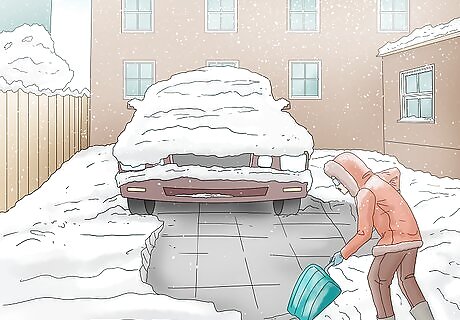
Clear a path to your vehicle. You’ll want firm footing as well as a place to put the snow you remove from your car. Clearing a path first will make the job easier. You could also wait until snow plows come through and clear the area, although sometimes they push more snow along the side of a road where cars may be parked.
Clearing Off Your Car

Start at the top. Clear the roof of snow first. Clear the hood and trunk areas as well before moving to the tires and road. Starting at the top ensures you only have to shovel the ground once; if you shovel snow from the ground then clear off the car, you’ll have to shovel the ground again to clear the snow you removed from the car. Though it may seem easier to leave snow on top of your car, it creates a hazard. Snow and ice can fall down over the windshield while driving which can block your view. If your vehicle is taller than you are, use a small stepladder and a broom to push off the snow. Be sure not to push the snow into the street, as this could create difficulty when you are ready to drive away. Shovel the removed snow well away from the car, other cars, and pedestrian walkways. The intention is to clean your car without creating more snow hazards.

Clear the doors. Dig snow away from the doors, especially the driver’s door. This will enable you to get into the car and start it, which will help melt snow and ice from the windows and other areas.
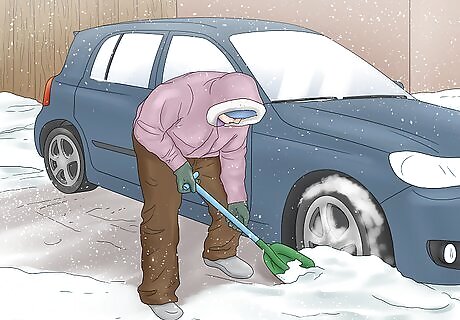
Shovel snow away from the tires. Remove snow from underneath as well as in the front and in the back of your tires. Be sure that there aren’t any chunks of ice or icicles anchoring your tires to the ground, as that will prevent you from easily driving out of the spot. If ice is present, try to knock it down with your broom. You can also put salt down around your tires to help melt the ice and snow. Be sure not to get it on your car, as it is corrosive.

Dig out your tailpipe. Clearing your tailpipe is a must; use your shovel to remove snow that has built up around the tailpipe and the back of your car. Leave at least 1 ft (0.31 m) of room to allow the exhaust fumes to escape. Otherwise, exhaust backs up into the car and can cause fatal carbon monoxide poisoning. Ensure the area around your tailpipe is clear before starting your car.
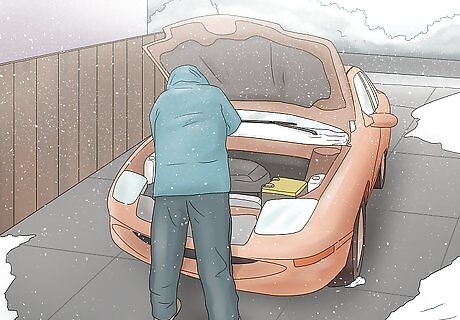
Check under the hood. After a major blizzard, snow may have filled the engine compartment. If so, prop the hood open, remove the snow, and leave the hood open to let everything dry off. Also check your windshield washer outlets to make sure they are clear as you may need to clean your windows often during winter driving.
Preparing to Drive Away

Start the car and let it defrost for 15 to 30 seconds. Turn on the heat and all defrosters. This will help melt snow and ice as well as give you a place to warm up once you are done digging.Turn on your headlights to help melt the snow and ice from the lenses. Leave the engine running and the heat and defrosters on while you finish removing the ice from the windshield and windows. Ensure you have enough gasoline to let the car idle while you are removing the rest of snow and still reach your destination. If you don’t have a key fob and your locks are frozen, use lock de-icer if you have it. If not, you could try heating up your key with a lighter or matches before inserting it into the lock. Be careful not to burn your hands or gloves! Don’t force the lock, or you may end up needing a locksmith.

Clear the windshield and windows. Do this after you start your car so the heat and defrosters make the job a bit easier. Use an ice scraper to clear the windshield, side windows, side mirrors, back window and any parts of the roof and hood that are not yet free of ice. Do not pour warm water on the windshield as this can cause the glass to crack! You should also free up the wipers, if they are frozen. Remove snow and ice from your headlights and taillights as well.
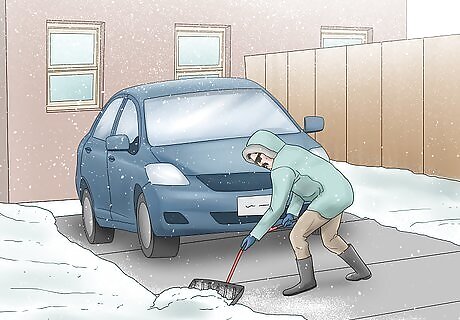
Dig out a path to drive away. Clear any large piles of snow or ice that will get in the way of you driving your car away from the spot you were parked in. Use a low gear and a low speed to help you move the car away from the spot. You may want to put salt, sand, or cat litter around your tires to help you gain traction when attempting to drive away. The gritty material is easier for your tires to grab onto than snow and ice. Rock your car or get a push to help you gain momentum. If no one is around to help you push the car, you can alternate between reverse and drive to get the car moving. Be sure to let the engine return to neutral before shifting gears.



















Comments
0 comment